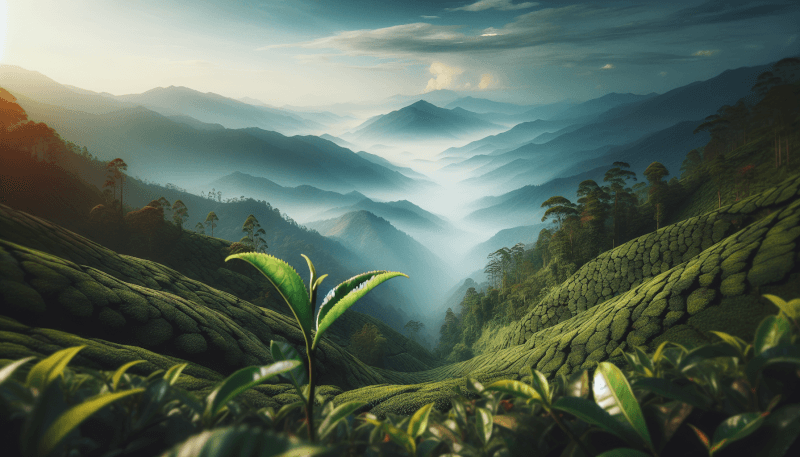Tea is a beloved beverage enjoyed by many around the world, but have you ever considered how altitude can affect the taste and quality of your brew? In this article, we will explore the fascinating relationship between altitude and tea brewing, giving you a better understanding of how this factor can significantly impact the flavors and aromas in your cup. So, grab your favorite tea leaves and join us on a journey to unravel the mysteries of altitude’s influence on your daily cup of tea.

Altitude and Tea Growing Regions
Introduction to tea growing regions
Tea is a beloved beverage that is enjoyed by people all over the world. It has a rich history and a wide variety of flavors and aromas that cater to different preferences. One of the key factors that contribute to the unique characteristics of tea is the altitude at which it is grown. Tea plants thrive in specific regions that offer optimal growing conditions, and altitude plays a crucial role in determining the flavor profiles of the tea produced in these areas.
Factors affecting tea flavor
The flavor of tea is influenced by various factors, including the type of tea plant, cultivation practices, processing methods, and environmental conditions. Altitude, in particular, has a significant impact on the overall flavor and quality of tea. The combination of factors present at higher altitudes creates a unique environment that contributes to the development of complex and distinct flavors in tea leaves.
Altitude’s role in tea flavor
Altitude plays a vital role in shaping the flavor profiles of tea. The conditions found at higher altitudes produce teas with nuanced flavors, exquisite aromas, and delicate textures. Understanding how altitude affects tea flavor can help tea enthusiasts appreciate the intricate characteristics of their favorite brews and explore new varieties that suit their taste preferences.
The Relationship Between Altitude and Tea Flavor
Why altitude affects tea flavor
Altitude affects tea flavor due to the different environmental factors that come into play at higher elevations. Tea plants that grow at higher altitudes experience cooler temperatures, increased solar radiation, lower oxygen levels, and different soil compositions. These factors cause the tea leaves to develop distinctive characteristics that contribute to the final flavor of the brewed tea.
How altitude affects tea flavor
The impact of altitude on tea flavor is primarily reflected in the chemical composition of the tea leaves. Tea plants at higher altitudes receive more sunlight, which leads to increased production of certain chemical compounds, such as amino acids and polyphenols. These compounds contribute to the complex flavors and aromas found in high-altitude teas. Additionally, the cooler temperatures slow down the growth of the tea leaves, allowing them to accumulate more flavor compounds. As a result, teas grown at higher altitudes tend to have richer, more nuanced flavors compared to those grown at lower elevations.
Examples of high-altitude teas
Numerous tea-growing regions around the world are known for producing exceptional high-altitude teas. Darjeeling in India, Nuwara Eliya in Sri Lanka, the Wuyi Mountains in China, and Kenya’s Rift Valley are renowned for their unique teas that showcase the influence of altitude on flavor. These regions have distinct climatic conditions and terroir that contribute to the exceptional taste profiles of their teas.
Factors at Higher Altitudes
Lower oxygen levels
One of the main factors at higher altitudes is the lower oxygen levels. As the altitude increases, the oxygen content in the air decreases. This reduced oxygen availability affects the biochemical processes within the tea plants and alters the flavor development. The lower oxygen levels stimulate the production of certain compounds, such as polyphenols, which can contribute to the astringency and complexity of high-altitude teas.
Cooler temperatures
Cooler temperatures prevail at higher altitudes, which slow down the growth of the tea plants. This slower growth allows the leaves to develop more concentrated flavors and aromas. The extended maturation period also gives the plants time to accumulate desirable compounds, resulting in teas with unique taste profiles.
Increased solar radiation
Tea plants at higher altitudes are exposed to increased solar radiation due to the thinner atmosphere at those heights. This additional sunlight stimulates the production of amino acids, which are responsible for the savory and umami flavors found in high-altitude teas. The combination of cool temperatures and increased solar radiation creates the ideal conditions for the tea plants to synthesize these compounds and develop their characteristic taste.
Different soil composition
The soil composition at higher altitudes also differs from that found at lower elevations. The mountainous terrain often consists of rocky terrain with nutrient-rich soils. These soils tend to have higher mineral content, which can contribute to the unique flavors found in teas grown at higher altitudes. The specific mineral composition of the soil interacts with the tea plants’ root systems, influencing the uptake of nutrients and affecting the overall flavor profile of the tea leaves.
Effects on Tea Brewing
Extraction rate of compounds
When brewing high-altitude teas, the altitude at which the tea leaves were grown can impact the extraction rate of compounds during brewing. The lower oxygen levels at higher altitudes can affect the solubility of certain compounds, potentially leading to differences in the strength and intensity of flavors in the brewed tea. Experimentation with brewing parameters, such as water temperature and steeping time, can help optimize the extraction and enhance the overall drinking experience.
Aroma and taste profile
The altitude at which tea is grown contributes to its unique aroma and taste profile. High-altitude teas often exhibit delicate floral notes, a subtle sweetness, and a smooth, refined taste. The combination of climate, altitude, and cultivation techniques results in teas with remarkable complexity and depth of flavor. Tea enthusiasts can savor the nuances of these teas by focusing on the fragrances and tasting notes that are characteristic of high-altitude brews.
Brewing temperature and steeping time
To fully appreciate the flavors of high-altitude teas, it is essential to consider the brewing temperature and steeping time. The recommended brewing parameters may vary depending on the specific tea, but generally, lower water temperatures and slightly longer steeping times are recommended for high-altitude teas. This allows for a more gentle extraction of flavors, preventing the tea from becoming overly bitter or astringent. Experimenting with different brewing techniques can help uncover the optimal way to enjoy the unique characteristics of each high-altitude tea.

Famous High-Altitude Tea Regions
Darjeeling, India
Darjeeling, located in the Indian Himalayas, is famous for its prized high-altitude teas. The region’s cool temperatures and mist-shrouded slopes contribute to the unique characteristics of Darjeeling tea. Often referred to as the “Champagne of Teas,” Darjeeling tea offers delightful muscatel flavors with floral and fruity undertones.
Nuwara Eliya, Sri Lanka
Nuwara Eliya, nestled in the central highlands of Sri Lanka, is renowned for its high-altitude tea production. The region’s cool climate, with temperatures rarely exceeding 20 degrees Celsius, creates ideal conditions for growing tea. Nuwara Eliya teas are known for their brisk, delicate flavors, with hints of citrus and a refreshing fragrance.
Wuyi Mountains, China
The Wuyi Mountains in China are recognized as a UNESCO World Heritage Site and are home to some of the world’s most prized high-altitude teas. The unique terroir, with its rocky cliffs and misty atmosphere, contributes to the distinctive flavor of Wuyi Rock tea. These teas are famous for their rich mineral taste, a result of the unique soil composition and processing methods employed by local artisans.
Kenya’s Rift Valley
Kenya’s Rift Valley is a prime tea-growing region that benefits from its high altitude. The tea estates located in this area produce robust, full-bodied teas with malty and earthy notes. The altitude, combined with the rich volcanic soil, contributes to the bold and vibrant flavors that characterize Kenyan teas.
Darjeeling Tea: A Case Study
Introduction to Darjeeling tea
Darjeeling tea is often regarded as the pinnacle of high-altitude tea production. Grown in the picturesque slopes of the Indian Himalayas, Darjeeling tea is esteemed for its exceptional quality and unique flavor profile. The cool temperatures and misty climate of the region create the perfect environment for producing teas that are highly sought after by tea connoisseurs worldwide.
Unique flavor characteristics
Darjeeling tea is known for its muscatel flavor, which offers a complex interplay of fruity, floral, and mildly astringent notes. The characteristic “muscatel” flavor is reminiscent of ripe grapes and is a result of the specific combination of factors found in Darjeeling’s high-altitude tea gardens. The unique taste profile of Darjeeling tea is a delight to the palate and sets it apart from teas grown at lower elevations.
Cultivation and processing
The cultivation and processing of Darjeeling tea are done with meticulous care to preserve its exceptional qualities. The tea gardens in Darjeeling are situated at altitudes ranging from 2,000 to 8,000 feet, ensuring the plants benefit from the region’s cool climate and abundant sunshine. The leaves are carefully plucked by hand, preserving their integrity and preventing damage. The teas undergo a withering process, followed by rolling, oxidation, and firing, all of which contribute to the development of the unique muscatel flavor and distinctive appearance of Darjeeling teas.

Nuwara Eliya Tea: A Case Study
Introduction to Nuwara Eliya tea
Nuwara Eliya, located in the heart of Sri Lanka’s central highlands, is synonymous with producing high-quality teas. The region’s steep hillsides and cool climate create an exquisite backdrop for cultivating tea. Nuwara Eliya teas are highly regarded for their delicate flavors and fragrant aromas, making them a favorite among tea enthusiasts.
Distinctive flavor notes
Nuwara Eliya teas possess delicate yet distinct flavor notes that set them apart from teas grown in other regions. The cool temperatures and abundant rainfall in Nuwara Eliya result in slow leaf growth and the accumulation of flavor compounds. This, coupled with the misty climate, contributes to the teas’ unique flavor profile, characterized by a delightful citrusy undertone and a refreshing briskness.
Tea estates and production methods
The tea estates in Nuwara Eliya employ traditional cultivation and processing methods that have been passed down through generations. The plants are grown at altitudes ranging from 4,000 to 7,000 feet, ensuring they benefit from the region’s favorable climate. The tea leaves are hand-plucked to ensure only the finest leaves are selected for production. The leaves undergo withering, rolling, oxidation, and firing processes, carefully executed by skilled artisans, resulting in teas that capture the essence of Nuwara Eliya’s terroir.
Wuyi Rock Tea: A Case Study
Introduction to Wuyi Rock tea
Wuyi Rock tea, also known as Yancha, is a highly revered category of tea produced in the scenic Wuyi Mountains of China. The region’s unique landscape, characterized by rocky cliffs and abundant mineral-rich soil, contributes to the distinctive taste of these teas. Wuyi Rock tea is celebrated for its rich, mineral flavor and captivating aroma, making it a favorite among tea connoisseurs worldwide.
Rich, mineral taste
The rich mineral taste of Wuyi Rock tea is a testament to the region’s terroir. The tea plants are grown in the mineral-rich soil found in the Wuyi Mountains, which imparts unique flavors to the tea leaves. The combination of minerals and the rocky environment create teas with robust and complex flavors, often described as having a distinctive “rock taste.” This taste profile is highly prized by tea aficionados and is a defining characteristic of Wuyi Rock teas.
Traditional processing techniques
Wuyi Rock tea production involves traditional processing techniques that have been refined over centuries. The leaves are harvested by hand and then meticulously processed to preserve their unique flavors. The leaves undergo specific steps, including withering, rolling, oxidation, and firing, which are carried out by skilled artisans. The combination of traditional processing methods and the unique characteristics of Wuyi Mountain terroir result in teas that embody the essence of ancient tea culture and delight the senses.

Kenyan Rift Valley Tea: A Case Study
Introduction to Kenyan tea
Kenya is renowned for its tea production, and the Rift Valley region plays a significant role in the country’s tea industry. Teas grown in the Rift Valley are known for their bold and robust flavors, making them popular choices for everyday consumption. The altitude and climatic conditions of the region contribute to the unique flavor profiles and vibrant characters found in Kenyan teas.
Bold and robust flavors
Kenyan teas are known for their robust and full-bodied flavors. The high altitude of the Rift Valley, combined with the volcanic soils, creates an ideal environment for growing tea. The plants at these elevations undergo slower leaf growth, contributing to the accumulation of flavor compounds. The unique combination of altitude, soil composition, and processing techniques results in teas with a bright, brisk flavor and a rich, malty taste.
Impact of altitude on Kenyan tea
The altitude at which tea is grown in the Rift Valley plays a vital role in shaping the flavor of Kenyan teas. Tea plants at higher elevations experience cooler temperatures, increased solar radiation, and lower oxygen levels, all of which contribute to the development of the tea leaves’ flavor profiles. These factors, combined with the region’s volcanic soil, create teas that are distinctive, flavorful, and highly sought after by tea lovers worldwide.
Conclusion
Summary of altitude’s impact on tea brewing
Altitude plays a crucial role in shaping the flavor profiles of tea. The environment at higher altitudes affects the chemical composition of the tea leaves, leading to the development of complex and distinct flavors. Factors such as lower oxygen levels, cooler temperatures, increased solar radiation, and different soil composition all contribute to the unique characteristics of high-altitude teas.
Appreciating high-altitude teas
Understanding the impact of altitude on tea brewing allows for a deeper appreciation of the diverse flavors and aromas found in high-altitude teas. Exploring famous tea-growing regions such as Darjeeling, Nuwara Eliya, the Wuyi Mountains, and Kenya’s Rift Valley gives tea enthusiasts the opportunity to discover teas with exceptional taste profiles. By adjusting brewing parameters and experimenting with different brewing techniques, tea lovers can unlock the full potential of high-altitude teas and embark on a flavor journey like no other. So next time you brew a cup of tea, consider the altitude it was grown at and savor the unique characteristics that make each tea experience truly special.



